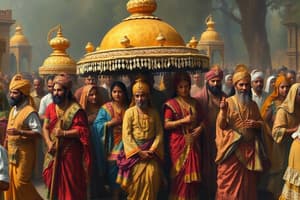Podcast
Questions and Answers
¿Dónde se ubica el Monasterio de las Nazarenas en relación con la Iglesia de las Nazarenas?
¿Dónde se ubica el Monasterio de las Nazarenas en relación con la Iglesia de las Nazarenas?
- En el centro de Lima
- Frente a la Iglesia de las Nazarenas
- Detrás de la Iglesia de las Nazarenas
- Al lado de la Iglesia de las Nazarenas (correct)
¿Cuál es el punto final habitual de la procesión del Señor de los Milagros?
¿Cuál es el punto final habitual de la procesión del Señor de los Milagros?
- Iglesia de Nuestra Señora Virgen del Carmen (correct)
- Plaza Mayor
- Iglesia de San Pedro
- Catedral de Lima
¿Qué hacen los participantes de la procesión del Señor de los Milagros mientras recorren las calles de la ciudad?
¿Qué hacen los participantes de la procesión del Señor de los Milagros mientras recorren las calles de la ciudad?
- Queman incienso y rezan (correct)
- Venden recuerdos religiosos
- Colocan adornos en la calle
- Realizan bailes tradicionales
¿Qué se transporta desde el Monasterio de las Nazarenas a diferentes lugares de la ciudad durante la procesión?
¿Qué se transporta desde el Monasterio de las Nazarenas a diferentes lugares de la ciudad durante la procesión?
¿Qué se espera durante la procesión del Señor de los Milagros en Lima?
¿Qué se espera durante la procesión del Señor de los Milagros en Lima?
¿Cuál es el nombre de la réplica que se transporta durante la procesión del Señor de los Milagros?
¿Cuál es el nombre de la réplica que se transporta durante la procesión del Señor de los Milagros?
¿Desde dónde comienza la procesión principal del Señor de los Milagros en Lima?
¿Desde dónde comienza la procesión principal del Señor de los Milagros en Lima?
¿Qué lugar importante de Lima sirve como parte de la ruta procesional, permitiendo que el público interactúe con la celebración religiosa?
¿Qué lugar importante de Lima sirve como parte de la ruta procesional, permitiendo que el público interactúe con la celebración religiosa?
¿Qué color de vestimenta usan los fieles que se alinean a lo largo de las calles durante la procesión del Señor de los Milagros?
¿Qué color de vestimenta usan los fieles que se alinean a lo largo de las calles durante la procesión del Señor de los Milagros?
¿Cuál es el punto final de la procesión del Señor de los Milagros antes de que la réplica sea devuelta al monasterio al día siguiente?
¿Cuál es el punto final de la procesión del Señor de los Milagros antes de que la réplica sea devuelta al monasterio al día siguiente?
Study Notes
Religious Procession in Lima: Exploring Cristo de Pachacamilla, Avenida Tacna, Nazarenas Monastery, and More
Lima, the capital city of Peru, is renowned for its vibrant culture and rich heritage, particularly its religious traditions. One of the most significant events in Lima's religious calendar is the annual procession of the Lord of Miracles, or Señor de los Milagros, which takes place throughout October and culminates on November 1st. This procession involves various subtopics, including Cristo de Pachacamilla, Avenida Tacna, Nazarenas Monastery, and the overall procession route.
Cristo de Pachacamilla
Cristo de Pachacamilla, also known as Brown Christ, is a significant historical figure in Lima's religious landscape. The image of Cristo Moreno was believed to have been painted on a wall in the 1650s by a former slave of Angolan descent in Pachacamilla, a deprived barrio located near the current city center. The wall where the image appeared was already being used as a place of worship by some devotees, including slaves. Despite numerous earthquakes over the years, the image survived and eventually became known as Cristo de Pachacamilla. Its enduring presence led to the construction of a church, Iglesia las Nazarenas, nearby, and later a larger shrine to house the image.
Avenida Tacna
During the Lord of Miracles procession, one of the key points of interest is Avenida Tacna, a bustling street in Lima. Here, the procession begins as the replica of the painting is carried from the Monastery of Las Nazarenas.
Nazarenas Monastery
Nazarenas Monastery plays a crucial role in the religious procession. Located next to the Church of the Nazarenas, the monastery houses a replica of the original Cristo Moreno painting. During the procession, the replica is carefully transported from the monastery to various locations throughout the city.
Procession Route
The Lord of Miracles procession route varies slightly each year, but generally starts at the Monastery of Las Nazarenas and ends at the Church of Our Lady Virgin of Carmen. Along the way, the procession passes through prominent landmarks such as the Plaza Mayor, Lima Cathedral, and Church of San Pedro. Participants in the procession include the replica of the Cristo Moreno painting, as well as cargadores, cantoradas, and other individuals involved in carrying the replica.
City Streets
As the Lord of Miracles procession winds its way through the city streets, tens of thousands of spectators gather to witness the solemn parade. The faithful pray, burn incense, and take part in the celebration, hoping for miracles in their lives.
In conclusion, the religious procession in Lima is a unique blend of history, faith, and community spirit. It offers a fascinating glimpse into the city's diverse cultural heritage and the deep-rooted beliefs of its inhabitants.
Studying That Suits You
Use AI to generate personalized quizzes and flashcards to suit your learning preferences.
Description
Explore the religious traditions and significant landmarks of Lima, Peru, focusing on the annual Lord of Miracles procession, including the Cristo de Pachacamilla, Avenida Tacna, Nazarenas Monastery, and the procession route through the city streets.




